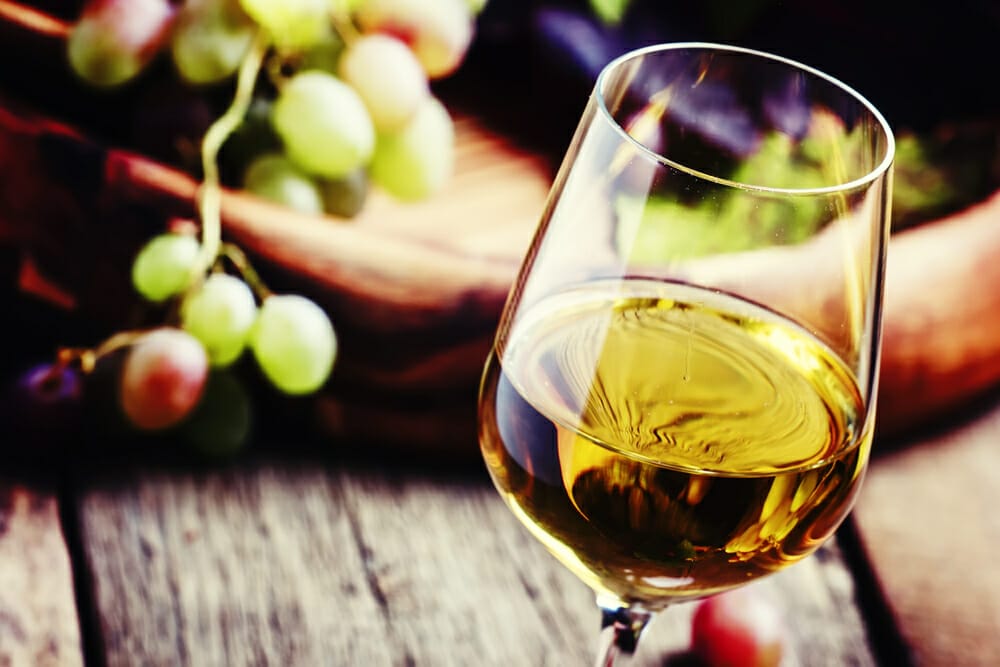What’s your wine of choice for the evening? Sauvignon Blanc? Chardonnay?
Or, what about a Moscato?
Moscato is a sweet, fruity, light wine that sits within the category of dessert wines. Light in alcohol content and delightful on the taste buds, it’s a great alternative to stronger wines!
Whether you’re just beginning to drink alcohol, want to cut back, or simply need a lighter alternative, Moscato is a wine that may be worth looking into.
If this sounds like you, read on! In this article, we will be covering:
- What Moscato is
- The different types of Moscato
- The alcohol content of Moscato and how it compares to other wines.
Let’s get into it!
What is Moscato?

Moscato, an aromatic and sweet wine, originates from the Piedmont region in North-western Italy.
In the present day, it has made its way into production across the world in locations that range from California to Australia.
The grapes that are used in production are called “Muscat Blanc à Petits Grains”, which are part of the Muscat grape variety.
What gives Moscato its sweeter flavors is the floral and fruity aromas these grapes provide.
The characteristics of being small and thick-skinned ultimately contribute to the aromatic profile of the grape.
Moscato can also have different classifications. They are as follows:
- Moscato d’Asti: The most famous Moscato wine of them all has a sweet and sparkling composition, with low alcohol content (5-7%). Fermentation is achieved via the Asti method which is short in duration to preserve the sweet flavors of the grapes.
The wine is characterized by the flavors of ripe stone fruit, citrus, and honey that shine through
- Asti Spumante: This variety of Moscato has an even sweeter taste to it than Moscato d’Asti but with a similar aromatic profile of stone fruit such as peach and apricot.
What does differ is the greater alcohol content and fermentation process. Rather than the Asti method, fermentation occurs in a pressurized tank to create bubbles
- Still Moscato: This Moscato differs from its counterparts due to being a still wine. It will also vary in sweetness depending on residual sugar content.
With that said, it still showcases the aromatic profile of Muscat grapes – just with a greater range of dry to sweet wines.
What Is Moscato Wine’s Alcohol Content?
Wine Type: Alcohol Content:
As shown above, alcohol content can differ depending on the type of Moscato you get.
Generally, Moscato sits around the 5-7% alcohol by volume (ABV) range. However, in wines such as Brown Muskat, which is fortified with a distilled spirit, alcohol content is elevated.
The sweet flavor profile still remains in these wines but with a bit more kick to it. It should be noted that if you intend on buying Moscato with its natural 5-7% ABV content, it’s important to specifically check the labeling at the back of the bottle.
How is Moscato’s Alcohol Content So Low?
The production of Moscato follows a specific fermentation process which allows for lower alcohol content.
The harvesting of the Muscat grapes is done in the early season which results in less sugar content.
Less sugar to convert to alcohol means a shorter fermentation process and ultimately less alcohol in the wine. This is what differentiates Moscato from the other wines with longer fermentation processes and therefore higher alcohol.
Is Moscato Considered To Be High In Alcohol?

Moscato is considered a low-alcohol wine in contrast to other types such as Cabernet Sauvignon or even those that are fortified.
It is associated with other low-alcohol wines (such as Riesling) in cooler climates. Riesling from Germany and Grüner Veltliner from Austria often sit with Moscato in the single-digit ABV range.
More moderate ABV wines include Sauvignon Blanc and Chardonnay, which come from areas such as New Zealand with cooler and sunny climates.
These tend to have an alcohol content of 11-13% ABV, which is more standard – the middlemen of wines, if you will.
A high alcohol content for wine can be anywhere around the 15% ABV mark. These wines, which include Cabernet Sauvignon and Amarone della Valpolicella, come from the warm climates of locations such as California or Southern France.
Additionally, wines that are fortified with spirits exceed alcohol content even more! In fact, they can get up to 25% ABV.
Is Moscato Considered A Strong Wine?
What is a strong wine? For many, a strong wine is considered one that has a high alcohol content.
These types of wines require lower pouring lines for a standard drink and tend to get you drunker faster when consuming similar amounts to their lower alcohol counterparts.
Consider the type of wine called Port. Brands such as Cockburn’s 20-year-old Tawny Port contain a staggering 20% ABV – 15% more alcohol than your standard Moscato!
These stronger wines are typically fortified with distilled spirits to achieve this high alcoholic profile.
Additionally, you can find wines such as Shiraz which is produced without fortification, and yet still has an alcohol content of around 15% ABV thanks to natural processes.
These high-alcohol wines put into perspective Moscato’s lack of strength. As such, Moscato is typically not considered a strong wine.
How Much Moscato Does It Take To Get Drunk?
Even if it’s not a particularly strong wine, there’s no doubt that Moscato can still get you drunk.
While it is light and has a low ABV percentage, it still contains alcohol. Don’t let the lower numbers deceive you into thinking you’ll escape a hangover!
What’s important to note is that everyone will become drunk on Moscato in different quantities. Factors that influence this are tolerance, body weight, gender, age, and rate of consumption.
With that said, it will definitely take more than a couple of glasses to get drunk from Moscato due to its low alcohol content.
According to the Blood Alcohol Content (BAC) calculator from the University of New Mexico, the average male can consume 10 standard glasses of Moscato in one hour before reaching the legal intoxication limit.
The average woman, on the other hand, would only need 6. This is a lot of liquid to consume in just one hour to get drunk!
Then again, with the sweet and light flavor profile of Moscato, it’s probably not too difficult – especially in comparison to stronger wines.
Exactly how drunk you get will differ from individual to individual. For instance, a lighter, younger woman will likely get more drunk from a particular amount of Moscato than a heavier man.
From the number of glasses outlined above, you may be thinking it is possible to drink a whole bottle of Moscato. While this is true, it’s not recommended!
One bottle of Moscata typically has an equivalent of around 5 standard glasses of wine in it. If having the whole bottle at a rapid rate is the plan for the night, you may be in for intoxication and a bad hangover – especially considering Moscato’s high sugar content.
The best advice to stay healthy and safe is to consume in moderation over a prolonged period of time, just like with any other wine.
Final Thoughts
Does Moscato get you drunk? Yes, absolutely.
What differentiates Moscato from other wines is how much of it you need to get drunk.
Moscato is a sweet and light wine originating from the Piedmont region of Italy, and the fruity aromas from the Muscat Blanc à Petits Grains grapes make Moscato an easy, pleasant drink.
It may be the reason behind accidentally downing too many glasses and getting drunk on this lower percent alcoholic wine!
Moscato can be found in the form of Moscato d’Asti, Asti Spumante, and Still Moscato – all of which have slightly different profiles, varying by fermentation process and sweetness.
What remains the same is the 5-7% ABV content amongst most brands. Don’t be fooled by these numbers, however; intoxication is still very much possible, depending on how much you drink and your size, gender, and age!
FAQs
Yes, you can. Moscato contains alcohol in it (5-7% ABV), which means you can get tipsy from drinking it. The amount of Moscato required to get tipsy will vary from individual to individual depending on tolerance, size, age, and gender.
No, Moscato is not strong. Moscato has some of the lowest alcohol contents of all the wine types. This is because of the shorter fermentation process, which preserves the sweet flavors. Nonetheless, it still contains alcohol and has the potential to make you intoxicated.
It is possible to drink a whole bottle of Moscato. With that said, it is not recommended! One bottle is equivalent to 5 standard glasses of wine, which may result in a bad hangover when combined with the high sugar content.
Yes, Moscato can be a good wine for beginners. Due to the low alcohol content of Moscato, it is perfect for people who don’t drink often or have just started drinking (such as younger individuals). Beginners won’t get drunk as fast, and will be safer because of this.
- Moscato vs Roscato: A Comprehensive Comparison of Sweet Wines - December 15, 2023
- Should White Wine Be Chilled? Expert Insights on Serving Temperature - December 14, 2023
- Moscato vs Riesling: A Sweet Wine Showdown - December 8, 2023










![Moscato vs. Chardonnay: 10 Key Differences [2023] Moscato vs Chardonnay](https://e25kn4v6x6d.exactdn.com/wp-content/uploads/2023/09/Moscato-vs-Chardonnay.jpg?strip=all&lossy=1&resize=150%2C150&ssl=1)